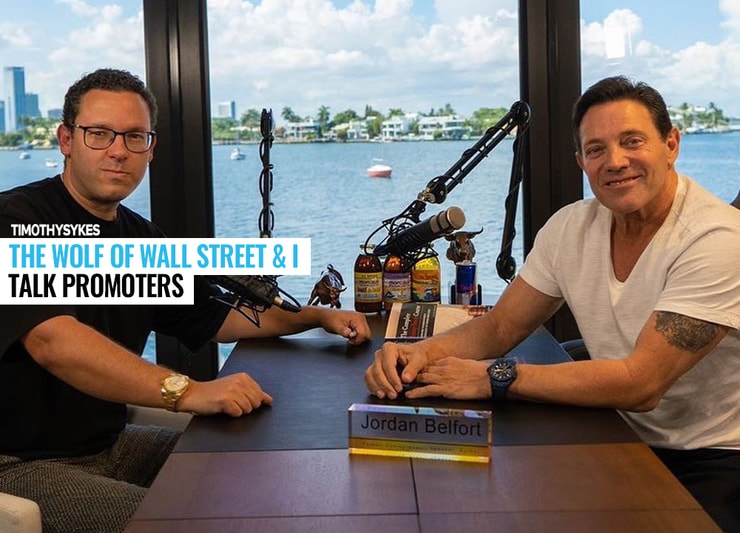I bought shares of a company after the FBI raided their headquarters.
That kind of surprised Jordan Belfort, AKA The Wolf of Wall Street.
I recently joined him on his podcast Wolf’s Den, for an hour-long discussion on all things trading.
As we talked, it became clear that although times change, promoters and their dirty tricks remain the same.
Belfort appreciated how I crafted a strategy to exploit promoters and now teach my students to do the same.
He gets that there are plenty of scams, and most of these stocks probably won’t exist ten years from now.
But as our conversation continued, he and I both covered critical insights into the inner workings of promoters…
Concepts I want you to know whether you use them to craft a strategy that exploits promoters or simply helps you avoid getting tangled in their nets.
Promoters Don’t Want the Stock to Crash

For those of you who don’t know, Jordan Belfort was on the wrong side of promoters and admits as much.
The movie The Wolf of Wall Street is a semi-biographical film about his rise and fall on Wall Street.
Today, he is a motivational speaker, salesperson, and entrepreneur.
Back when Belfort was still on Wall Street, promoters worried about their stocks crashing.
A quick move would bring more scrutiny and cause people to realize it’s a scam.
As he pointed out, if a stock traded at $10 and belonged at $2, promoters had a choice – let the stock crash or try and prop it up.
Using Nikola Motors (NKLA) as an example, I explained how promoters like to create a ‘soft landing’ for shares.
They tell people the drop is nothing to worry about, that everything is fine. Just look at former Nikola Motors CEO Trever Milton for countless examples.
By ginning up interest in the stock, they do what Jordan Belfort said, try to keep the house of cards from collapsing.
That’s a big reason why my dip-buying strategy is so effective.
When a stock plummets 30%, 40%, 50%, or more, promoters start to get scared and active on social media. They’ll dump press releases about nothing just to get people interested in the company.
This creates huge bounces I incorporate into my 7-step penny stock framework.
Even if you aren’t interested in buying the stock for a bounce, it’s important to realize one thing…
Large rebounds don’t justify huge runs.
When many penny stocks bounce back, it isn’t because people finally see value. It’s because promoters duped people into snapping up shares.
I’m a History Teacher

Those who fail to learn from history are doomed to repeat it.
Markets have short memories.
While I wish I could say that speculative bubbles happen occasionally, I see them happen regularly.
Some are massive and last for months, if not years, like cannabis or cryptocurrencies.
This isn’t to say they aren’t tradeable or won’t be a real business in the future.
But when their beginnings are covered with promoters jawboning assets and creating Supernovas, it creates unsustainable price action.
What changes is how the promoters reach us.
A decade ago, it was all about emails and newsletters.
Before our StocksToTrade Breaking News Chat, my top students would hold webinars to explain how to optimize your Gmail, so you got promoter emails faster.
They had a list of dozens of Twitter accounts to follow.
Back in Beflort’s day, it was done over the phone.
The mediums promoters use to reach us have changed. But their goals remained the same.
However, some developments materially change the game.
For example, several years ago, I stopped shorting penny stocks.
As penny stock trading grew, more brokers opened intent on feeding short sellers, overcrowding the space.
That led to extraordinary price movements, as we saw recently with AMTD Digital Inc. (NYSE: HKD) where the stock shot up thousands of percentage points.
Sure, you can still make money on the short side. But one bad trade can wipe you out.
More Breaking News
- Aclaris Therapeutics Sees Tumultuous Times: Is it a Hidden Opportunity?
- Archer Aviation’s Latest Moves: A Tempest in Tech Stocks
- Grayscale’s Crypto Strategy: Could It Revolutionize Bitcoin Investment?
As I discussed in the interview, short selling got me into tiffs with Justin Beiber and Shaq when they promoted penny stocks.
Expect The Worst

I learned the hard way that you can be 100% right on an idea and still get it dead wrong.
There are terrible companies that trade over $100 per share.
Heck, some of them have been in business for decades.
We saw storied financial institutions flounder during the Great Recession.
Zoom Video Communications Inc. (NASDAQ: ZM) went from $100 a share to almost $600 during the pandemic as people clamored for their software.
Today, it trades below $80 with even more subscribers than they had during lockdowns.
The only thing that matters for any stock is price action.
People thought their 5,000-square-foot mansions were worth $3 million in 2007.
Two years later, those same homes sold for less than a million in short sales.
Whether you’re talking about a stock, crypto, a house, or even a chair doesn’t matter.
The only thing that matters is the price someone is willing to pay.
—Tim


Leave a reply